

 |
||
 |
||
Vol. 10 (1): June 2007 |
||
Conservation status and priorities of the critically endangered
|
 |
1. Parque Natural da Madeira, Qta do Bom Sucesso, Caminho do Meio, 9001-251 Funchal, Madeira – Portugal2. Department of the Environment, Science and Culture, Municipality of Funchal, Praça do Município, 9000-072 Funchal, Madeira – Portugal3. MOm/Hellenic Society for the Study and Protection of the Monk seal, 18 Solomou Str., 106 82 Athens, Greece |
|||
|
|
|
The Mediterranean monk seal is critically endangered. The main threats include habitat loss, intentional killing and accidental entanglement in fishing gear (Johnson et al., 2006). In the archipelago of Madeira (Madeira, Porto Santo, Desertas and Selvagens Islands) there is historical evidence of seals only at Madeira, where seals were once abundant (Machado 1979). However, in 1988 there were only 6-8 seals remaining in the area, at the Desertas Islands (Biscoito 1988). In 1989 the Parque Natural da Madeira Service (PNMS) initiated a Conservation Programme and in 1990 the Desertas Islands were declared a Nature Reserve. Efforts to protect the monk seal included the protection of the species and its habitat, scientific research and public awareness. The aims of this study were to record distribution, relative abundance, and basic demographic parameters of the species in the archipelago in order to assess its current conservation status and identify priority protection and management actions for the future.
Seals were monitored at the Desertas Islands using a non-invasive method, based on the direct observation of seals from 6 lookout-sites or while navigating by boat around the islands. Assessment of the population status at Madeira, Porto Santo and the Selvagens Islands was based on circumstantial reports of sightings received by PNMS. An effort to systematically collect these was initiated by PNMS in 2002 when a Monk Seal Information Network was established.
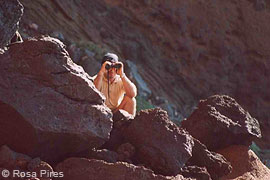 |
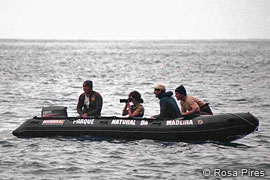 |
|
|
|
|
Desertas Islands
Distribution: During the 13099 hours of observation effort (1992-2005), 1258 sightings were recorded (Figure 1; average group size=1.7; maximum number of seals observed=9).
 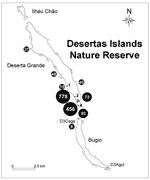  |
|
Fig. 1. (click on maps to enlarge) |
Population size: Four black males, 6 large-sized seals (from which, 5 were reproductive females), 1 medium-sized seal and 3 juveniles were identified. Annual birth rate increased significantly (Figure 2; r2 = 0.759, F = 47.120, P < 0.005). All 5 deaths recorded were due to natural causes.
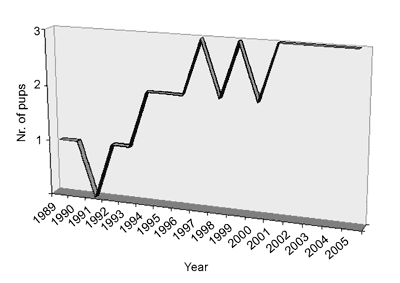 |
|
Fig. 2 |
Behaviour: From 1997 on, seals were seen occupying open beaches (Figure 3).
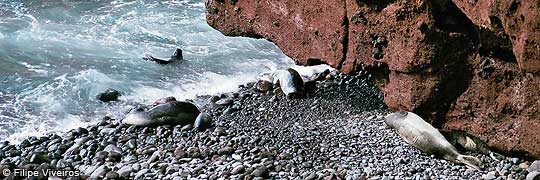 |
|
Fig. 3 |
Madeira, Porto Santo and Selvagens Islands
Distribution: 389 seal sightings were recorded (Figure 1) (1989 – 2005 – 87% of the sightings were recorded from 2002 on). Sightings of monk seals at Madeira, which were rare in the recent past, occur now frequently. Only 2 seals were sighted at Porto Santo, while no sighting occurred at the Selvagens Islands.
Population size: One black male and 1 large-sized seal (male) were confirmed to be resident.
Behaviour: 36 Human/seal interactions were recorded; in several occasions seals caused damage to fishing equipment.
The monk seal population in the archipelago of Madeira is estimated to number 20-30 adult individuals distributed over Madeira and the Desertas islands. The findings of the study suggest that the species remains critically endangered in the area but that its conservation situation has improved since and due to the implementation of effective conservation actions. Conservation priorities for the future include protecting suitable monk seal habitat, investigating seal–fisheries interactions, increasing environmental education and strengthening the regional legislation regarding the protection of the species.
Special thanks to: the staff of the Parque Natural da Madeira Service who made this study possible, and particularly to the reserve wardens who have been key elements in the monk seal conservation and research programme; to the Regional Government of Madeira through the Regional Secretary of Environment and Natural Resources for all the financial support and personal interest demonstrated throughout the project; to the Portuguese Navy for the invaluable help in patrolling the Nature Reserve and for the transport of staff and equipment.
Biscoito, M. J. 1988. Lobos marinhos que Futuro? Islenha 3:100-104.
Johnson, W.M., Karamanlidis, A.A., Dendrinos, P., de Larrinoa, P.F., Gazo, M., Gonzàlez, L.M., Güçlüsoy, H., Pires, R. and Schnellmann, M. 2006.Monk Seal Fact Files. Biology, Behaviour, Status and Conservation of the Mediterranean monk seal, Monachus monachus. The Monachus Guardian. [http://www.monachus-guardian.org/factfiles/medit01.htm, accessed 20 March 2007]
Machado, A.J.M. 1979. Os Lobos Marinhos (Genero Monachus, Fleming 1822) ) - Contribuição para o seu Estudo e Protecção. Museu do Mar, Unidade de Mamalogia, Cascais: 1-242.
This poster was presented at the 21st Conference of the European Cetacean Society:
Integrating Science and Management for Marine Mammal Conservation. 22-25 April 2007, San Sebastian, Spain.
Copyright © 2007 Rosa Pires, Henrique C. Neves, Alexandros A. Karamanlidis, The Monachus Guardian. All Rights Reserved |